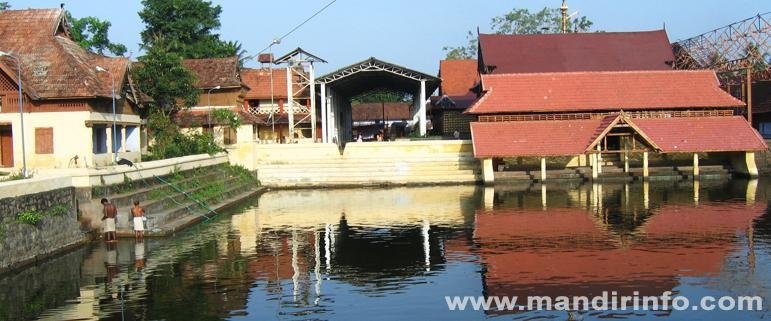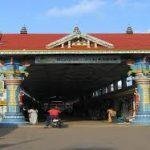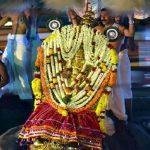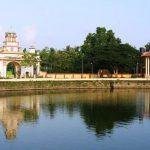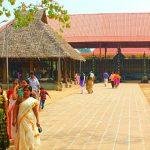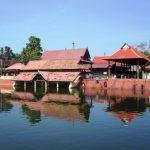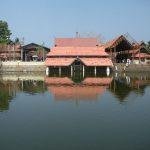Ambalappuzha Sri Krishna Temple, Alapuzha, karnataka
| Date built: | AD 790 |
|---|---|
| Deity: | – |
| Architectural style: | – |
| Major festivals | – |
| Locale: | Ambalappuzha |
| District:: | Alapuzha |
| Address: | SH 12, Ambalapuzha, Kerala 688561 |
| Phone | 04772272090 |
Ambalappuzha Sri Krishna Temple (Malayalam: അമ്പലപ്പുഴ ശ്രീകൃഷ്ണ ക്ഷേത്രം) is a Hindu temple in Ambalappuzha, Alapuzha district of Kerala, in south India.
The Ambalappuzha Sri Krishna Temple is believed to have been built during 15th – 17th AD by the local ruler Chembakasserry Pooradam Thirunal-Devanarayanan Thampuran.
The idol at Ambalapuzha is likened to Parthasarthi (പാർത്ഥസാരഥി) with a whip in the right hand and a Shankhu (sacred conch) in the left. This temple is directly associated to the Guruvayoor Sree Krishna Temple. During the raids of Tipu Sultan in 1789, the idol of Sri Krishna from the Guruvayoor Temple was brought to the Ambalappuzha Temple for safe keeping. It kept safely for 12 years.
The payasam served in the Ambalappuzha Temple is famous among Hindu devotees. This sweet pudding made of rice and milk has an interesting mythological legend behind it.It is believed that Guruvayoorappan reaches here daily at the time of Palpayasa Nedyam
Architecture
Ambalapuzha is 14 km south of Alappuzha town. Ambalapuzha’s fame is attributed to this temple. The 16th century-built temple is very famous in South Kerala and its prasadam (deity’s food given to devotees as a token of blessing), Palpayasam (milk kheer), more commonly known as Ambalapuzha Palpayasam is mouth-watering and very famous throughout Kerala. The deity of the temple situated on the banks of Ambalapuzha River is Sri Krishna. Ambalapuzha itself means the river of temple (ambala means temple and puzha means river). The birth of this temple is twined with fascinating stories. The Champakasseri King, Moolam Thirunal Devanarayanan, and his mentor Vilwamangalath Swamiyar while cruising in a boat in Ambalapuzha river heard music tune of a flute from the bank. They shored the boat and moved forward towards the music emanting point when they noticed a beautiful boy playing the flute sitting on a branch of a peepul tree. The religious stalwart Vishwamangalam concluded that this child is none other than divine Krishna. Both, the king and the mentor, prostrated before the child after circumambulating the tree. When they rose from the ground the child was not there. Vishwamangalm lost no time to advice the king to build a temple for Sri Krishna at the spot. A temple thus soon came up there.
There is a conflicting story behind the installed idol. The king ordered idol was not installed as the priests noticed some inaccuracies in the sculpting. Instead, an idol was borrowed from a temple and installed. This is one version. The other version is that the inaccuracies of the king orderd idol was corrected and installed the same. Let it be either way. The idol is of a smiling naughty boy. The idol was brought by a boat and the Chambakulam Boat Race in June/July is in commemoration of this. The 3 ft high idol is always seen covered in sandalwood paste.
King Devanarayanan placed his crown at the feet of Lord Krishna in this temple and dedicated his kingdom to the Lord. The last king of Devanarayanan’s dynasty placed the keys of his granary and treasury before the Lord after his defeat by Travancore.
The walls around the sanctum sanctorum are beautiful with paintings of Dasavathra (ten incarnation of Vishnu).
The main festival of the temple is the 10-day Arattu Utsavam in Meenam (March/April). Processions by several caparisoned tuskers accompanied by vadya-melams (percussion instrument musics) and performances of Velakali, a martial art form, are the main attractions. The procession ends with enchanting fireworks. During the festival devotees are offered a feast and the diners are treated with utmost honour. It is believed, Lord Krishna presents incognito to dine along with the devotees.
Legend / Local stories
According to the legend, God Krishna once appeared in the form of a sage in the court of the king who ruled the region and challenged him for a game of chess (or chaturanga). The king being a chess enthusiast himself gladly accepted the invitation. The prize had to be decided before the game and the king asked the sage to choose his prize in case he won. The sage told the king that he had a very modest claim and being a man of few material needs, all he wished was a few grains of rice. The amount of rice itself shall be determined using the chess-board in the following manner. One grain of rice shall be placed in the first square, two grains in the second square, four in the third square, eight in the fourth square, sixteen in 5th square and so on. Every square will have double of its predecessor.
Upon hearing the demand, the king was unhappy since the sage requested only a few grains of rice instead of other riches from the kingdom which the king would have been happy to donate. He requested the sage to add other items to his prize but the sage declined.
So the game of chess started and needless to say the king lost the game. It was time to pay the sage his agreed-upon prize. As he started adding grains of rice to the chess board, the king soon realised the true nature of the sage’s demands. By the 20th square, the number had reached one million grains of rice and by the 40th square, it became one million million. The royal granary soon ran out of grains of rice. The king realised that even if he provides all the rice in his kingdom and his adjacent kingdoms, he will never be able to fulfill the promised reward. The number of grains was increasing as a geometric progression and the total amount of rice required to fill a 64-squared chess board is ((2^64) – 1) which is equal to the number 18,446,744,073,709,551,615 translating to trillions of tons of rice.
Upon seeing the dilemma, the sage appeared to the king in his true-form, that of God Krishna. He told the King that he did not have to pay the debt immediately but could pay him over time. The king would serve paal-payasam (made of rice) in the temple freely to the pilgrims every day until the debt was paid off.
Photo Gallery
How to Reach:
Contact Details
Official Address

